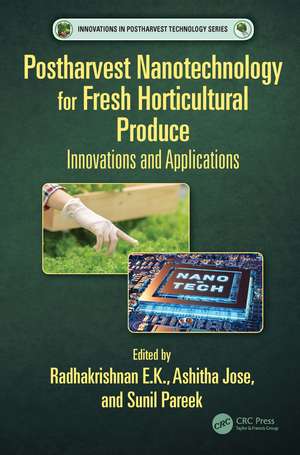Postharvest Nanotechnology for Fresh Horticultural Produce: Innovations and Applications: Innovations in Postharvest Technology Series
Editat de Radhakrishnan E.K., Ashitha Jose, Sunil Pareeken Limba Engleză Hardback – 29 dec 2023
The impact of various nano-systems developed through material engineering on the shelf-life enhancement and storage of fresh horticultural produce will have revolutionary effects on post-harvest management in the coming years. Hence, Postharvest Nanotechnology for Fresh Horticultural Produce has been edited to advance understanding of material development, intelligent selection of nanomaterials to ensure the nontoxic nature, and future perspectives of nanotechnology on postharvest produce. This includes various types of nanoparticles exploited for the postharvest management, their mechanism of action, varied applications and material engineering, along with natural products including essential oils and plant bioactives, modelling of various tailor-made materials to meet the required properties of the packed food, advancements in the nanotechnological applications for the minimally processed food, and the toxicity concerns.
Key Features:
· Describes advances in nanotechnology for postharvest management
· Includes extensive details on the applications of material engineering for post-harvest applications using nanotechnology and future aspects
· Provides extensive data on the types of nanomaterials used and the fabrication methods employed for the design of tailor-made products for the post-harvest management
This book reviews the current scientific advancements and future prospects of the nanotechnological interventions in meeting the quality and quantity standards of the horticultural produce and minimally processed food and will be a valuable reference for beginners, researchers, subject experts, and industrialists.
Preț: 1293.57 lei
Preț vechi: 1577.52 lei
-18% Nou
Puncte Express: 1940
Preț estimativ în valută:
247.53€ • 259.09$ • 206.02£
247.53€ • 259.09$ • 206.02£
Carte tipărită la comandă
Livrare economică 31 martie-14 aprilie
Preluare comenzi: 021 569.72.76
Specificații
ISBN-13: 9780367675011
ISBN-10: 0367675013
Pagini: 485
Ilustrații: 49 Tables, black and white; 41 Line drawings, black and white; 12 Halftones, black and white; 53 Illustrations, black and white
Dimensiuni: 178 x 254 x 27 mm
Greutate: 1.06 kg
Ediția:1
Editura: CRC Press
Colecția CRC Press
Seria Innovations in Postharvest Technology Series
ISBN-10: 0367675013
Pagini: 485
Ilustrații: 49 Tables, black and white; 41 Line drawings, black and white; 12 Halftones, black and white; 53 Illustrations, black and white
Dimensiuni: 178 x 254 x 27 mm
Greutate: 1.06 kg
Ediția:1
Editura: CRC Press
Colecția CRC Press
Seria Innovations in Postharvest Technology Series
Public țintă
Professional ReferenceNotă biografică
Dr. Radhakrishnan E.K is currently working as Assistant Professor in School of Biosciences, Mahatma Gandhi University, Kottayam, Director of Business Innovation and Incubation Centre (BIIC) and as Joint Director of Inter University Centre for Organic Farming and Sustainable Agriculture (IUCOFSA), Mahatma Gandhi University, Kottayam, Kerala, India.
Ms. Ashitha Jose is currently pursuing her Ph.D in Biochemistry at School of Biosciences, Mahatma Gandhi University, Kottayam, India. Her area of research is food packaging materials with incorporated nanoparticles. So far she has authored several book chapters of various publishing groups.
Dr. Sunil Pareek is working as Associate Professor at NIFTEM, Kundli, Haryana. He is Head of the Department of Agriculture and Environmental Sciences and also Director (IQAC).
Ms. Ashitha Jose is currently pursuing her Ph.D in Biochemistry at School of Biosciences, Mahatma Gandhi University, Kottayam, India. Her area of research is food packaging materials with incorporated nanoparticles. So far she has authored several book chapters of various publishing groups.
Dr. Sunil Pareek is working as Associate Professor at NIFTEM, Kundli, Haryana. He is Head of the Department of Agriculture and Environmental Sciences and also Director (IQAC).
Cuprins
1. Introduction to nanotechnological applications in the postharvest processing of fresh horticultural produce 2. Synthesis and characterization methods for the nanobased materials for the postharvest storage of horticultural produce 3. Organic nanoparticles in postharvest management and the mechanism involved 4. Cellulose nanoparticles for postharvest management and the mechanism involved 5. Inorganic/ metallic nanoparticles in postharvest management and the mechanism involved 6. Mechanism of silver nanoparticles based postharvest technologies 7. Nanoclay based methods for the postharvest processing of horticultural produce 8. Hybrid nanomaterials for postharvest storage 9. Engineering the nanobased packaging materials for the post harvest storage 10. Advancements in the essential oil based packaging materials 11. Bio active nano-based packaging for postharvest storage of horticultural produce 12. Nanotechnology in shelf life enhancement of minimally processed horticultural produce 13. Modeling and simulation of gas barrier properties of nanocomposites used for packaging applications 14. ZnO nanoparticles based methods for the minimally processed horticultural produce 15. Phytonanocomposites for minimally processed horticultural produce 16. Toxicity aspects of nanoparticles and their composites being used in the Postharvest Nanotechnology 17. Life cycle assessment: a tool to evaluate the environmental impact of nanomaterials used in food packaging – modification suggested by authors 18. Global status of nanotechnology policies in packaging sector 19. Future Scope of Nano Based Methods for the Improvement of Postharvest Technologies and Increased Shelf Life of Minimally Processed Food 20. Nano based methods for the improvement of postharvest technologies and increased shelf life of minimally processed food
Descriere
This book has been edited to advance understanding of material development, intelligent selection of nanomaterials to ensure the nontoxic nature, and future perspectives of nanotechnology on postharvest produce.




